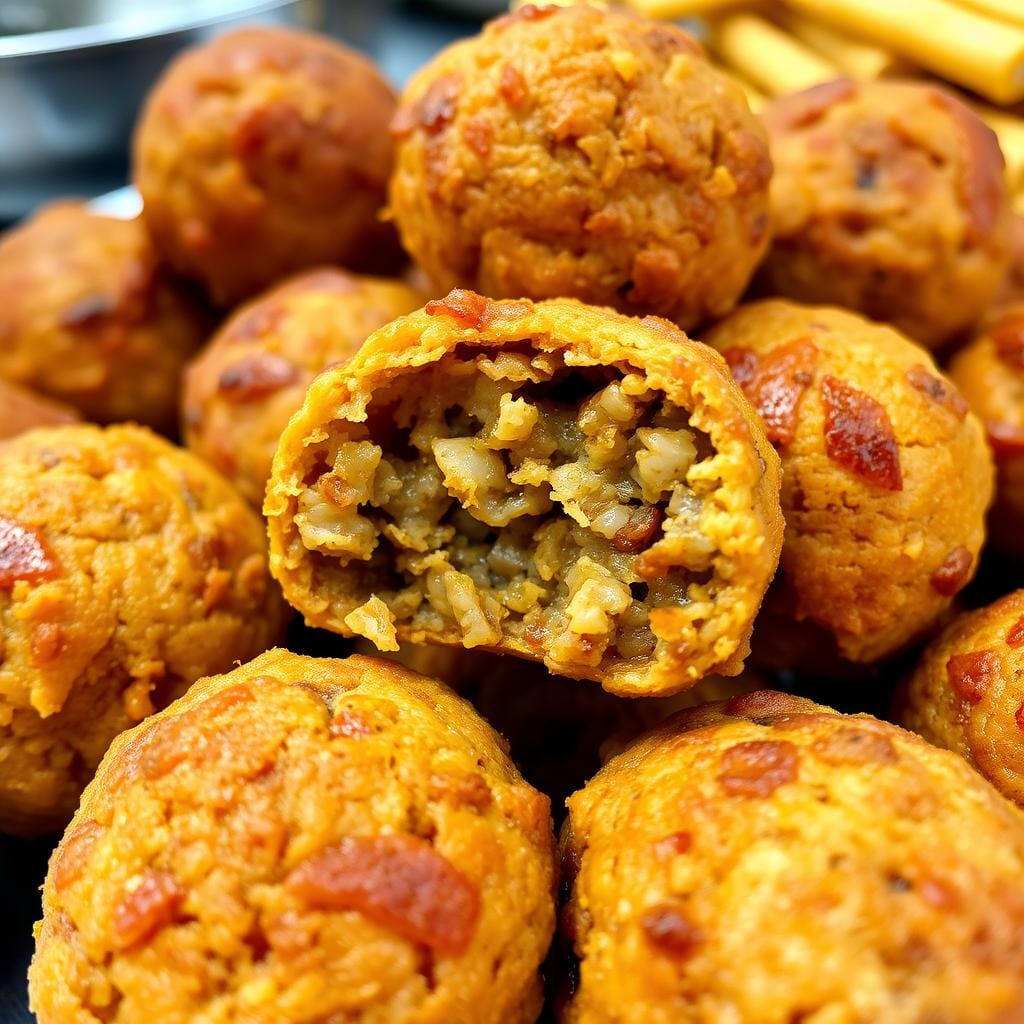Ever pulled out sausage balls from the oven, only to find them dry and crumbly? It’s a common issue that can make you miss the moist, tasty experience you hoped for. But don’t worry, we’ve got you covered. Today, we’ll show you how to fix this problem and make your sausage balls moist and delicious.

Key Takeaways
- Understand the common causes behind dry sausage balls, such as too much biscuit mix, incorrect meat-to-Bisquick ratio, and over-processing the mixture.
- Discover the science behind moisture and how to achieve the perfect balance of ingredients for moist, tender sausage balls.
- Learn the essential ingredients and techniques for creating the perfect sausage ball texture, from choosing the right type of sausage to mastering the mixing process.
- Explore moisture-adding solutions, storage methods, and troubleshooting tips to ensure your sausage balls stay fresh and flavorful.
- Unlock the secrets to baking sausage balls that are consistently moist and delicious every time.
Common Causes Behind Dry Sausage Balls
If your sausage balls are dry and crumbly, there are a few reasons why. Knowing what causes this can help you fix it. This way, you can make them moist and full of flavor.
Too Much Biscuit Mix
Using too much biscuit mix, like Bisquick, can make sausage balls dry. The mix helps hold things together, but too much can soak up moisture. Make sure to use the right amount of sausage ball ingredients.
Incorrect Meat-to-Bisquick Ratio
The mix of sausage and biscuit mix is also important. If it’s not balanced, your balls might be too dry or dense. Try different ratios to find the perfect mix for baking tips sausage balls.
Over-processing the Mixture
Too much mixing can also make sausage balls dry. When you mix too much, the sausage and cheese get tough. Be gentle when sausage ball troubleshooting and avoid mixing too much.

“The key to moist, flavorful sausage balls is finding the right balance of ingredients and handling the dough with a light touch.”
Why Are My Sausage Balls So Dry? Understanding the Science Behind Moisture
If your sausage balls are dry and crumbly, it’s time to learn about moisture. The moisture in sausage balls and their sausage ball texture depend on fat content, protein binding, and heat. These factors are crucial.
Fat is key to keeping sausage balls moist. The fat in sausage acts as a lubricant. It stops proteins from binding too tightly, which helps keep moisture in. If there’s not enough fat, the proteins can dry out, making the balls dense and crumbly.
Protein binding is also important. As sausage balls bake, proteins form a network. If this network is too tight, it can trap moisture. This leads to dry, tough balls. Finding the right balance is essential for juicy, tender sausage balls.
Heat distribution during baking is another factor. Uneven heat can cause some parts to overcook while others stay moist. To avoid this, it’s important to ensure even heat. This helps achieve a moist and flavorful result.
By understanding these scientific principles, you can improve your sausage ball recipe. You can prevent dryness and enjoy moist, tender balls every time.

Essential Ingredients for Perfect Sausage Balls
Making delicious sausage balls needs the right ingredients. You need the perfect sausage and binding agents. Each part is key to getting the right moisture and texture. Let’s look at what makes sausage balls moist and tasty.
Choosing the Right Type of Sausage
The sausage you pick affects your balls’ moisture. Go for a high-quality, fresh sausage with more fat. This fat keeps the balls moist while baking. Don’t use lean sausages, as they can make the balls dry.
The Role of Cheese in Moisture
Adding cheese to your recipe is a big plus for moisture. Cheese’s fat and melting help keep the balls together. Use shredded cheddar, Parmesan, or a mix for the best taste.
Optimal Binding Ingredients
- Bisquick or baking mix: These help bind the sausage and add texture.
- Eggs: Adding eggs makes the mixture more moist and cohesive.
- Cream cheese: A bit of softened cream cheese keeps the balls tender.
Choosing the right sausage, cheese, and binders makes your sausage balls juicy and tasty. The trick is to find the right mix of ingredients for the perfect moisture and texture.
The Perfect Ratio: Balancing Your Ingredients
Getting the right mix of ingredients is key to making moist, tasty sausage balls. The mix of sausage and Bisquick (or other biscuit mix) affects the balls’ texture and moisture. Finding the right mix helps avoid dry, crumbly balls.
Start with a 1:1 ratio of sausage to Bisquick. For example, use 1 pound of sausage with 1 cup of Bisquick. Adjusting this ratio slightly can help you find the perfect balance for your personal taste preferences and baking conditions.
The cheese you add also matters for moisture. Use about 1 cup of shredded cheese for every 1 pound of sausage. This cheese helps the ingredients stick together and adds a creamy texture.
- Start with a 1:1 ratio of sausage to Bisquick, then adjust as needed.
- Add about 1 cup of shredded cheese per 1 pound of sausage.
- Consider adding a small amount of cream cheese or milk to further enhance moisture.
By finding the perfect balance of sausage ball ingredients, you can prevent your sausage balls from becoming dry. This ensures they are moist and delicious every time. Try different ratios to find your ideal baking tips for sausage balls and prevent dry sausage balls.
Proper Mixing Techniques for Moist Sausage Balls
Making the perfect sausage balls starts with mixing. How you mix the ingredients affects their moisture and texture. We’ll look at hand mixing versus machine mixing, temperature, and what to check for the right consistency.
Hand Mixing vs. Machine Mixing
You can mix sausage balls by hand or with a machine. Each method has its own benefits and things to consider:
- Hand Mixing: This method lets you control the texture and mix ingredients gently. It’s slower and may take more effort.
- Machine Mixing: A stand mixer or food processor speeds up mixing. But, be careful not to overmix to avoid a dry, tough texture.
Temperature Considerations
The temperature of your ingredients and the mixing area matters. It’s best to mix with ingredients at room temperature. This helps them bind better and prevents a crumbly texture. The mixing area should be comfortable, not too hot or cold.
Signs of Proper Consistency
The ideal sausage ball dough is smooth and slightly sticky. It should hold its shape well when scooped or rolled. If it’s too dry, adding cream cheese or milk can help.
Knowing how to mix and the importance of temperature ensures your sausage balls are moist and delicious every time.
Temperature and Timing: Critical Baking Factors
To make perfectly moist sausage balls, you need to get the baking right. The oven temperature and cooking time are key to avoiding dry, crumbly results. We’ll look into the science behind the best baking conditions and share tips to keep your sausage balls tender and juicy.
The Ideal Oven Temperature
The oven temperature is crucial when baking sausage balls. Aim for a temperature between 375°F to 400°F. This range helps the sausage and cheese melt together, while the biscuit mix cooks evenly without drying out.
Precise Cooking Time
The sausage ball cooking time is also vital. If they’re underbaked, they’ll be gooey in the middle. Overbaking makes them dry and crumbly. Generally, bake them for 18 to 22 minutes, depending on their size. Watch them closely and adjust the time as needed for the perfect texture.
Preventing Dry Sausage Balls
- Preheat your oven thoroughly to the recommended temperature range.
- Use a reliable oven thermometer to ensure accurate temperature readings.
- Rotate the baking sheet halfway through the cooking time to promote even browning.
- Check the sausage balls a few minutes before the recommended time and adjust accordingly.
- Consider covering the baking sheet with foil or parchment paper to help retain moisture.
Mastering temperature and timing ensures your sausage balls are moist, tender, and full of flavor. With practice, you’ll impress everyone at gatherings or potlucks.
| Oven Temperature | Cooking Time | Result |
|---|---|---|
| 375°F – 400°F | 18 – 22 minutes | Perfectly moist and tender sausage balls |
| Below 375°F | Over 22 minutes | Undercooked, gooey centers |
| Above 400°F | Less than 18 minutes | Dry, crumbly sausage balls |
Moisture-Adding Ingredients and Solutions
Getting the right texture for your sausage balls is all about balance. If they’re dry, don’t worry. There are many ways to make them tender and juicy again.
Cream Cheese Options
Adding cream cheese is a popular way to moisten sausage balls. Its creamy texture and mild taste help counter dryness. It also helps the ingredients stick together. Use softened or room temperature cream cheese for the best results.
Alternative Binding Agents
- Shredded cheese: Mixing shredded cheddar, Parmesan, or other hard cheeses with the sausage can help bind and retain moisture.
- Eggs: Lightly beaten eggs can bind the ingredients together, adding moisture.
- Breadcrumbs or panko: A small amount can soak up excess moisture, making the texture tender and cohesive.
Liquid Addition Tips
If your sausage balls are still too dry, add a bit of liquid. A tablespoon or two of milk, cream, or sausage drippings can moisten the mixture without changing the texture.
Remember, the secret to moist, tasty sausage balls is finding the right mix of ingredients and techniques. Try these solutions to get the perfect texture every time.
Storage and Reheating Methods to Maintain Moisture
Keeping your sausage balls moist is key, not just when they’re fresh out of the oven. The right storage and reheating methods are essential. This ensures they stay soft and tasty, whether you’re enjoying them later or sharing them with others. Here are some tips to keep your sausage balls from drying out.
Refrigeration and Freezing
For a few days, store your sausage balls in an airtight container in the fridge. This keeps them moist and fresh. For longer storage, freeze them on a baking sheet, then put them in a freezer-safe bag. Frozen, they stay good for up to 3 months, keeping their texture perfect.
Reheating with Care
When reheating, be gentle to avoid drying out the sausage balls. The microwave can be too harsh. Instead, try these methods:
- Oven Reheating: Place the sausage balls on a baking sheet and warm them in a 350°F oven for 8-10 minutes, or until heated through.
- Air Fryer Reheating: Arrange the sausage balls in a single layer in your air fryer basket and reheat at 350°F for 5-7 minutes, flipping halfway through.
- Stovetop Reheating: Warm the sausage balls in a skillet over medium heat, flipping occasionally, until heated to your liking.
By following these tips, your sausage balls will always have the perfect sausage ball texture.
| Storage Method | Maximum Duration | Reheating Recommendation |
|---|---|---|
| Refrigerator | 4 days | Oven (350°F for 8-10 minutes) |
| Freezer | 3 months | Air Fryer (350°F for 5-7 minutes) |
“Proper storage and reheating techniques are the keys to preventing dry sausage balls and maintaining their irresistible texture.”
Troubleshooting Common Texture Problems
If your sausage balls are dry, crumbly, or uneven, don’t worry. There are easy fixes. Let’s look at common texture issues and how to fix them for moist, tasty sausage balls.
Crumbling Sausage Balls
Dry, crumbly sausage balls often come from too much biscuit mix or wrong meat-to-biscuit ratio. Use the right amount of Bisquick and mix gently. Adding cream cheese or sour cream can help the dough stick together better.
Tough, Chewy Sausage Balls
Overworking the dough makes sausage balls tough. Mix and shape gently. Don’t knead or squeeze too hard. Also, don’t use too much sausage compared to other ingredients.
Uneven Cooking
Uneven cooking can be due to different sizes or wrong oven temperature. Make sure all balls are the same size. Use an oven thermometer to check the temperature. Rotate the baking sheet halfway for even cooking.
“The key to perfect sausage balls is finding the right balance of ingredients and using the proper mixing and baking techniques.”
By fixing these texture issues, you’ll make moist, tender sausage balls. With a bit of troubleshooting, you can get the perfect texture every time.
Conclusion
In this guide, you’ve learned how to make moist and tasty sausage balls. You now know how to avoid dryness and make your sausage recipes better. You can make sure your baking sausage balls are perfect every time.
Choosing the right sausage and mixing it with Bisquick is key. Adding the right ingredients helps too. Follow the right steps to get the perfect texture and avoid dryness.
Creating perfect sausage balls is all about trying new things and paying attention to details. With what you’ve learned, you’re ready to impress your loved ones. Enjoy making and eating these delicious treats!

